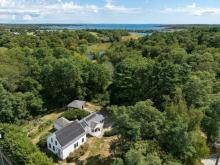Bullseye: DNRT aims to reduce deer population, five archers selected
White-tail deer overpopulation remains a problem in Massachusetts and Dartmouth is no different.
According to the Dartmouth Natural Resource Trust, Mass Wildlife estimates that there are 30 to 50 deer per square mile in eastern Massachusetts, and a recent survey by Mass Audubon at Allens Pond Sanctuary in Westport counted 56 deer per square mile.
In 2023, Dartmouth Police recorded 1,803 interactions between people in cars and with deer. In addition, the overpopulation of deer has had a major impact on crops and the understory in forests, which is the layer of trees and shrubs between the forest floor and canopy, reducing its ability to regenerate, according to DNRT Executive Director Nick Wildman.
However, the Trust has taken steps to assist in reducing the population size by allowing a select few archers to hunt on the DNRT properties that do not include trails, are not for conservation purposes and are large enough to accommodate safe archery hunting.
The Board of Directors approved the plan in June, and five hunters have been selected and taken through the DNRT screening and training process. Wildman said they will be required to follow all state hunting laws, which includes the archery start date of Tuesday, Oct. 7 and end date Saturday, Nov. 30.
The following properties will be used by the selected hunters: Shingle Island Reserve, Griswold Reserve, Barzabiel Washburn Reserve, ASM Realty Reserve, Faunce Reserve, Mary Rose Perry Agricultural Reserve and Teal Rock-Winsor Reserve.
“Our main goal is to make sure that our neighbors and the community know that our properties are not open to hunting,” Wildman said. “It's really meant to reduce the white tailed deer herd and not to provide a new recreational hunting opportunity.”
Archers will be reporting back to the DNRT weekly with data on their hunts and will be encouraged to donate venison to the state’s Share the Harvest Program, which serves those facing food insecurity.
“Our number one consideration was safety,” Wildman said. “By choosing only to do bow hunting, no firearms at all, we're really trying to make sure we're maximizing the safety aspect of this while trying to take a few deer off the landscape.”



.jpg)









